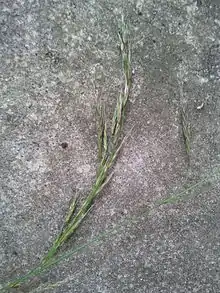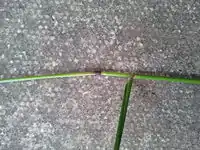Festuca gigantea
Festuca gigantea, or giant fescue, is a plant species in the grass family, Poaceae. Because this and other members of Festuca subgenus Schedonorus have more in common morphologically with members of the genus Lolium than with Festuca and often produce fertile hybrids with other Lolium species, Festuca gigantea has been recently published as Lolium giganteum (L.) Darbysh. (1993) and then as Schedonorus giganteus (L.) Holub (1998).[1][2][3] Sources vary as to which placement is more acceptable.[4][5][6][7]
| Giant Fescue | |
|---|---|
 | |
| giant fescue flower head | |
| Scientific classification | |
| Kingdom: | Plantae |
| Clade: | Tracheophytes |
| Clade: | Angiosperms |
| Clade: | Monocots |
| Clade: | Commelinids |
| Order: | Poales |
| Family: | Poaceae |
| Subfamily: | Pooideae |
| Genus: | Festuca |
| Species: | F. gigantea |
| Binomial name | |
| Festuca gigantea (L.) Vill. | |
Description



This grass can grow up to 2 metres. It is loosely tufted, hairless, and has auricles. It has dark red-purple leaf nodes, and there are six 8–13 mm long spikelets. Festuca Gigantea have long awns, forming flowers during the July to August period.
It is a common plant found especially on heavy, neutral and calcerous soils, in woodland, hedge banks and shady places.[8] It is said to grow best in moist woods.
Festuca gigantea produces fertile hybrids with perennial ryegrass and Italian ryegrass,[9] hence the confusion with its phylogeny and identification.
Nutrition value
Cattle and horses will readily eat its abundant foliage.
Similar species
Festuca altissima also known as Wood Fescue, is similar but is found in rocky woods, has spikelets which droop much more but are half as long, and ligules 3mm long.[10]
References
- "Stephen J. Darbyshire, Schedonorus treatment in Grass Manual on the Web (updated 2009)". Archived from the original on 2016-03-04. Retrieved 2013-02-27.
- R.J.Soreng, et al. (2012) A World-Wide Phylogenic Classification of Poaecea (Gramineae): căo (草), capim, çayır, çimen, darbha, ghaas, ghas, gish, gramas, graminius, gräser, grasses, gyokh, he-ben-ke, hullu, kasa, kusa, nyasi, pastos, pillu, pullu, zlaki, etc. (rev. 18 Oct 2012) (includes Schedonorus in Lolium in subtrib. Loliinae)
- Stephen J. Darbyshire (1993). "Realignment of Festuca subgenus Schedonorus with the genus Lolium (Poaceae)". Novon. 3 (3): 239–243. doi:10.2307/3391460. JSTOR 3391460.
- Schedonorus giganteus (L.) Holub, USDA-NRCS PLANTS Database, 2013-02-27
- "Festuca gigantea". Germplasm Resources Information Network. Agricultural Research Service, United States Department of Agriculture. Retrieved 2013-02-27.
- Schedonorus giganteus (L.) Holub, Integrated Taxonomic Information System (ITIS), 2013-02-27
- Lolium giganteum (L.) Darbysh., Catalogue of New World Grasses, Tropicos.org. Missouri Botanical Garden. 2013-02-27
- page 408, Wild Flowers of Britain and Ireland, by Marjorie Blamey, Richard Fitter, Alastair Fitter, published 2003, ISBN 0-7136-5944-0
- page 46, Collins Pocket Guide Grasses Sedeges Rushes and Ferns of Britain and Northern Europe, by R Fitter, A Fitter, A Farrer, published 1995, ISBN 0-00-219136-9
- page 27 The Observers book of Grasses, Sedges and Rushes, by Francis Rose, published 1976, ISBN 0 7232 1533 2